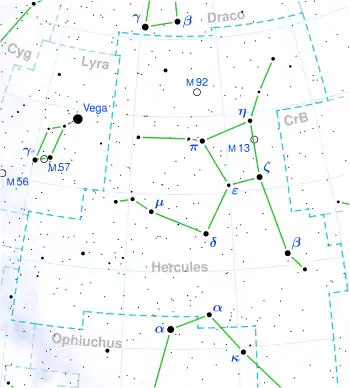| Observation data Epoch J2000 Equinox J2000 | |
|---|---|
| Constellation | Hercules |
| Right ascension | 17h 12m 07.91s |
| Declination | +45° 39′ 57.2″ |
| Apparent magnitude (V) | 10.02/10.25 |
| Characteristics | |
| Spectral type | M3 + M3.5 |
| Astrometry | |
| Radial velocity (Rv) | –19 ± 5 km/s |
| Proper motion (μ) | RA: +348.59 ± 5.68 mas/yr Dec.: –1624.84 ± 6.80 mas/yr |
| Parallax (π) | 156.66 ± 1.37 mas[1] |
| Distance | 20.8 ± 0.2 ly (6.38 ± 0.06 pc) |
| Orbit[2] | |
| Period (P) | 12.9512 ± 0.0096 yr |
| Semi-major axis (a) | 0.7620 ± 0.0015″ |
| Eccentricity (e) | 0.7430 ± 0.008 |
| Inclination (i) | 149.14 ± 0.25° |
| Longitude of the node (Ω) | 160.0 ± 1.3° |
| Periastron epoch (T) | 1991.032 ± 0.011[3] |
| Argument of periastron (ω) (secondary) | 99.0 ± 1.0° |
| Details | |
| Temperature | 3,272 ± 28[4] K |
| Metallicity [Fe/H] | –0.31 ± 0.17[4] dex |
| Other designations | |
| Gl 661 A: LFT 1326, LTT 15095, LHS 433, NLTT 44362 | |
| Gl 661 B: LFT 1327, LTT 15096, LHS 434, NLTT 44363 | |
| Database references | |
| SIMBAD | The system |
| A | |
| B | |
 Furuhjelm 46 Location of Furuhjelm 46 in the constellation Hercules | |
Furuhjelm 46, also known as HD 155876 and Gliese 661, is a nearby binary star system, consisting of two very similar red dwarfs, located in the constellation Hercules.
The star's duplicity was discovered by the Dutch astronomer Gerard Kuiper in 1934 in a systematic survey for duplicity of the known stars within about 25 parsecs from the Sun, carried out with the 36-inch telescope of the Lick Observatory.[5] Furuhjelm 46 is the nearest "true" (i. e. not brown dwarf) star system in Hercules, however, there is brown dwarf in this constellation, located closer: WISE 1741+2553.
References
- ↑ Söderhjelm, Staffan (1999). "HIP 84140". Visual binary orbits and masses post Hipparcos.
- ↑ From the Sixth Catalog of Orbits of Visual Binary Stars, based upon Hartkopf, W. I.; Mason, B. D.; McAlister, H. A. (1996), "Binary star orbits from speckle interferometry. VIII. Orbits of 37 close visual systems", Astronomical Journal, 111: 370–392, Bibcode:1996AJ....111..370H, doi:10.1086/117790
- ↑ Fractional Besselian year.
- 1 2 Rojas-Ayala, Bárbara; et al. (April 2012). "Metallicity and Temperature Indicators in M Dwarf K-band Spectra: Testing New and Updated Calibrations with Observations of 133 Solar Neighborhood M Dwarfs" (PDF). The Astrophysical Journal. 748 (2): 93. arXiv:1112.4567. Bibcode:2012ApJ...748...93R. doi:10.1088/0004-637X/748/2/93. S2CID 41902340.
- ↑ Kuiper, Gerard (1934). "Two New Close M-Dwarf Binaries of Large Parallax". Publications of the Astronomical Society of the Pacific. 46 (373): 235. Bibcode:1934PASP...46..235K. doi:10.1086/124479. S2CID 119814250.
External links
- Diagram of orbit from U.S.Naval Obs. site Archived 2016-03-03 at the Wayback Machine
This article is issued from Wikipedia. The text is licensed under Creative Commons - Attribution - Sharealike. Additional terms may apply for the media files.